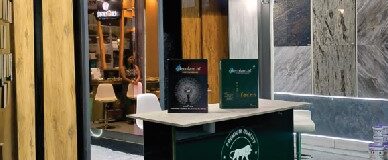
Price gap of plywood widening
- March 12, 2019
- 0
Price gap of plywood widening
 KUCHING: The price gap is widening between import prices of Sarawak plywood and its selling price in Japan.
KUCHING: The price gap is widening between import prices of Sarawak plywood and its selling price in Japan.
This is because export prices of Sarawak plywood to Japan are going up but the demand for such plywood in Japan has been stagnant.
“The price of 3×6 concrete forming panels have been unchanged at 1,320 yen per sheet FOB (free on board) truck, so the gap between export prices (of Sarawak plywood) and market prices in Japan continues spreading.
“Since last spring, future cost (of imported plywood) exceeded 1,500 yen (per sheet), so the contracts start declining,” according to the latest trade news from Japan Lumber Reports (JLR).
JLR has attributed the rising export prices of Sarawak plywood to Japan to the prolonged log shortage that has adversely affected the production of Sarawak plywood mills.
“In Sarawak,rain started since October and every day is rainy in November.
“Besides foul weather,the government restriction on illegal harvest (has resulted) log production decreased, so log inventories of local plywood mills continue low.
“Log inventories of plywood mills are about two weeks, and this kind of hand to mouth operation has been lasting for more than a year.
“Actually, some plywood mills had to shut down by log shortage about a year ago,” said JLR, its report of which is reproduced by the International Tropical Timber Organisation (ITTO) tropical timber market report (Jan 16-31, 2019).
JLR expects future export prices of Sarawak plywood to continue to climb.
It said in Tokyo Bay area, inventories of imported tropical hardwood uncoated concrete forming panels were dropping.
“Shipping companies are reluctant to call at Tokyo Bay ports due to congestion, which causes demurrage.
“Bulk carriers are not able to unload plywood without any space of warehouses, so the ships have to wait for unloading,” said JLR, predicting that there would not be any ship calling at the port until end-January.
The report said the congestion at Tokyo Bay ports since last summer was due to damages to ports in western Japan caused by heavy rains and typhoons, thereby resulting in ships rushing to Tokyo Bay ports to unload their cargoes.
The report said more than 50 percent of the warehouse inventories are owned by the wholesalers, who think it is safe to carry inventories rather than buying higher future cargoes even with storage charges.
“Therefore, there is very little unsold 3×6 concrete forming panel in the market now. Now the importers are asking 1,480 -1,500 yen per sheet FOB truck.”
JLR said with plywood volume decreasing, container shipping had been increasing, with volume doubled in one year since late last year, instead of bulk carriers.
On Japan’s plywood mills switching to Papua New Guinea (PNG) to source for logs after Sabah banned log exports in May last year, JLR said as these mills’ demand was much more than the supply volume from PNG, Japan needed, therefore, to keeping looking for other substituting logs sources.
Japan’s total log imports from PNG during the first 10 months in 2018 was 55,764 cu m, which was 215.6 percent higher than the same period in 2017.
“Cost of PNG’s mersawa (species) for plywood is higher than meranti of Sarawak.
Average log price in PNG is lower than Malaysia but cost of selected logs for plywood in higher than Sarawak.
“PNG is now the top log supply source for Japan.
“Japan imported 37,148 cu m of logs from Sabah in the first five months last year before the state government imposed the export ban. Sarawak’s log exports has dropped due to falling production volume and the government’s reduction in export quota.
Japan also imports laminated free board and solid wood lumber from China.
On domestic log supply in Japan, JLR said it continued to remain tight.
“Log production has been increasing in November with fair weather but sawmills still feel hungry, so they keep buying.
“The prices are simmering down with increasing log production but in general, price level stays high by strong demand. Lumber movement is recovering for pre-cutting plants but there is not enough strength to push the prices higher.
“Sawmills are caught in between high log lost and flat lumber prices,”it added.
Courtesy: Newsarawaktribune



























































